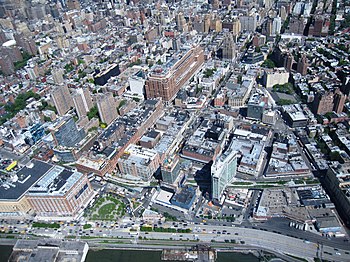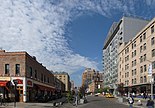Meatpacking District, Manhattan
Gansevoort Market Historic District | |
| Coordinates | 40°44′25″N 74°00′25″W / 40.74028°N 74.00694°W |
|---|---|
| Area | 44 acres (18 ha) |
| Architect | various |
| Architectural style | various |
| NRHP reference No. | 07000487[1] |
| Significant dates | |
| Added to NRHP | May 30, 2007 |
| Designated NYCL | September 9, 2003 |
The Meatpacking District is a
History
Pre-colonial
A Lenape trading station called Sapohanikan was on the riverbank, which, accounting for landfill, was located about where Gansevoort Street meets Washington Street today.[6][7][8] The footpath that led from Sapohanikan inland to the east became the foundation for Gansevoort Street,[9] which by accident or design aligns, within one degree, so that the Manhattanhenge phenomenon, where the setting sun crosses the horizon looking down the street, occurs at the spring and autumnal equinoxes.[10] In recognition of this history, petitions were made to call the 14th Street Park "Saphohanikan Park", although it appears no formal recognition was given.[11]
Initial development
The earliest development of the area now known as the Meatpacking District came in the mid-19th century. Before that it was the location of Fort Gansevoort
Construction of residences in the neighborhood – primarily
After the Civil War
When development began again after the war in the 1870s, the tenor of the neighborhood changed. Since it was no longer considered a desirable area to live in, construction of single-family residences was replaced with the building of multiple-family dwellings, and the continued internal industrialization increased. In addition an
Decline and resurgence
The area's decline began around the 1960s as part of the general decline of the waterfront area. Containerization of freight; the advent of supermarkets which changed the distribution pattern for meat, dairy and produce from a locally or regionally based system to a more national one; and the development of frozen foods and refrigerated trucks to deliver them were all factors in this, but meatpacking continued to be the major activity in the neighborhood through the 1970s. At the same time, a new "industry" of
In the 1980s, as the industrial activities in the area continued their downturn, it became known as a center for drug dealing and prostitution. Concurrent with the rise in illicit sexual activity, the sparsely populated industrial area became the focus of the city's burgeoning

Beginning in the late 1990s, the Meatpacking District went through a transformation. High-end
A catalyst for even greater transformation of the area was the opening in June 2009 of the first segment of the
Preservation
In September 2003 the New York City Landmarks Preservation Commission (LPC) established the Gansevoort Market Historic District,[22] and in 2007 New York State Parks Commissioner Carol Ash approved adding the entire Meatpacking District, an area which included both the Gansevoort Market Historic District and the neighborhood's waterfront, to the New York State and National Registers of Historic Places.[23] The state district was listed on the National Register on May 30, 2007 and included 140 buildings, two structures, and one other site.[1]
Gallery
-
Before gentrification, many meatpacking buildings had become derelict
-
The Herring Safe & Lock Company Building (1849) at the intersection of Ninth Avenue and Hudson Street at 14th Street
-
The Apple Store at 14th Street and Ninth Avenue
-
Hotel Gansevoort (right) and Pastis (left) on Ninth Avenue
-
TheStandard Hotel above the High Line
-
Spring equinox
-
View of W 14th St from The High Line
See also
- Chelsea, Manhattan
- Greenwich Village
- High Line (New York City)
- The Standard, High Line
Notes
- ^ Named after Peter Gansevoort, a general in the Revolutionary War
References
- ^ a b "National Register Information System". National Register of Historic Places. National Park Service. March 13, 2009.
- Village Voice. Archived from the originalon August 8, 2007. Retrieved February 28, 2008.
- ^ New York Times map of Meatpacking District
- ^ Mohney, Chris (September 25, 2006). "Close-Up on: The Meatpacking District". Gawker. Archived from the original on January 16, 2008. Retrieved February 28, 2008.
- ^ "Neighborhood - Meatpacking District Official Website". Meatpacking District Official Website. Retrieved November 21, 2016.
- ^ Hudson River Park Trust
- ^ Letter from J. Lee Compton, Chair, City of New York Manhattan Community Board 4 to Kathy Howe (March 8, 2007)
- )
- ^ Bolton, Reginald Pelham. Indian Paths in the Great Metropolis New York Museum of the American Indian, Heye Foundation, 1922. pp58-59
- ^ Earth System Research Laboratory
- ^ "Folkies Sing a Different TuneFor Village’s Chapel Buildin [sic]" New York Observer (February 12, 2001)
- ^ a b c d e f g h Shockley, Jay "Gansevoort Market Historic District Designation Report part 1", New York City Landmarks Preservation Commission (September 9, 2003)
- ^ Johnson, Clint. "A Vast and Fiendish Plot" New York Archive (Winter 2012)
- ^ New York City Names Gansevoort Market a Historic District Archived 2003-10-03 at the Wayback Machine, from the website of the National Trust for Historic Preservation
- ^ Gay, Tim (July 14–20, 2004). "Bring back the beefcake, and add some flowers too". The Villager. Retrieved August 12, 2011.
- ^ Renzi, Jen. "The raw and the cooked: From red light to limelight, New York's meatpacking district redesigns for fashion", Interior Design (4/1/2003)
- ^ Beth Landman (February 26, 2014). "NYC celebs remember iconic Meatpacking eatery Pastis". New York Post. Retrieved April 16, 2015.
- ^ Platt, Adam (May 21, 2005). "Top 5". New York. Retrieved September 19, 2012.
- ^ Steinberg, Jon (August 18, 2004). "Meatpacking District Walking Tour". New York. Retrieved February 28, 2008.
- ^ second
- ^ "Brian Rose Photography". Retrieved August 20, 2014.
- ^ Greenwich Village Society for Historic Preservation Save Gansevoort Market Archived May 25, 2008, at the Wayback Machine
- ^ Greenwich Village Society for Historic Preservation Meatpacking District Approved for Listing on State and National Register of Historic Places Archived July 17, 2012, at the Wayback Machine (11 April 2007)
External links
 Media related to Meatpacking District, Manhattan at Wikimedia Commons
Media related to Meatpacking District, Manhattan at Wikimedia Commons- Meatpacking District Improvement Association website







